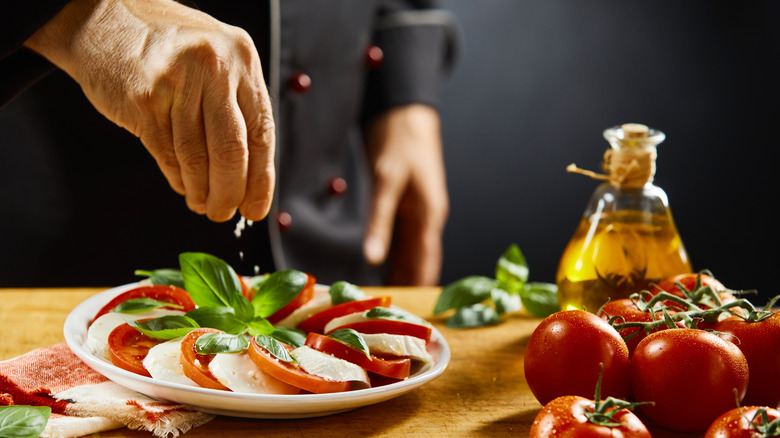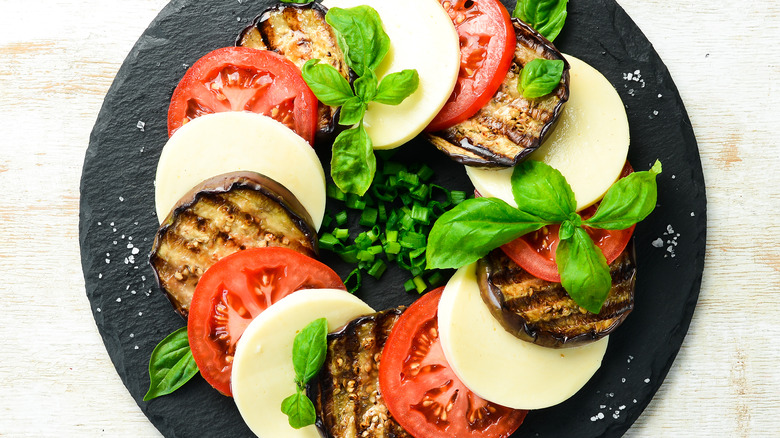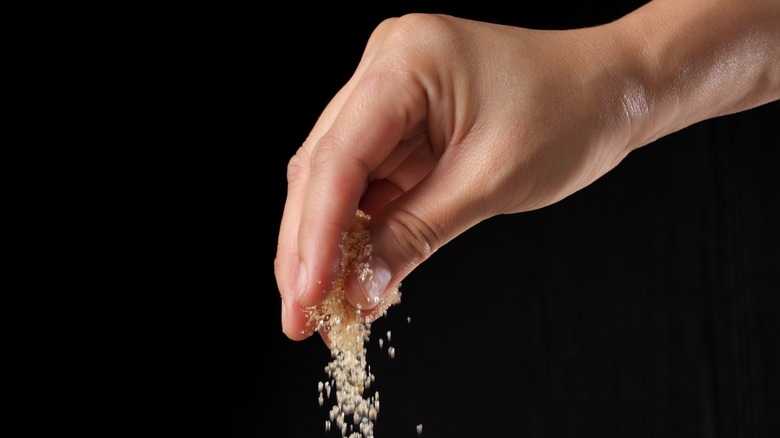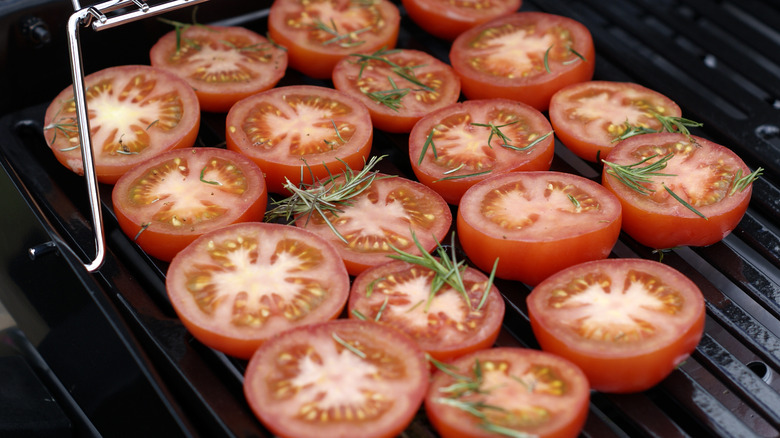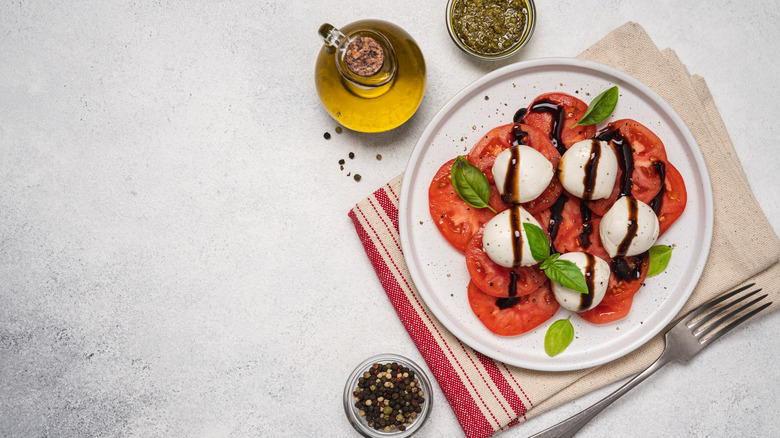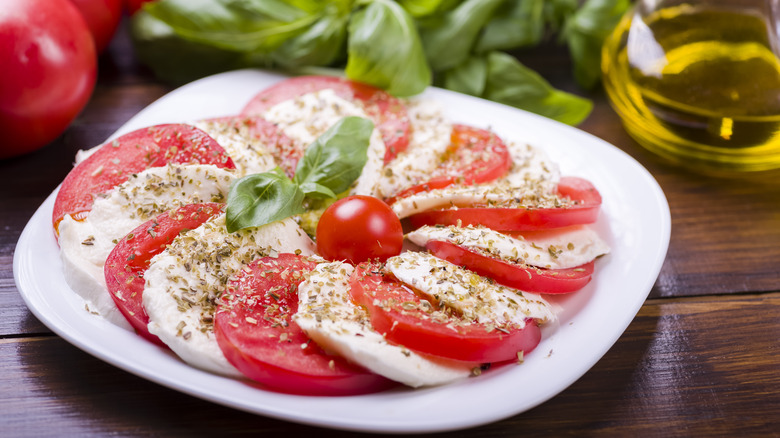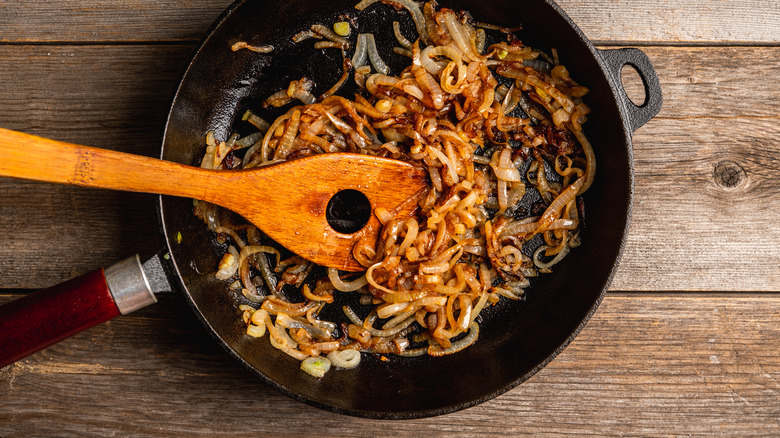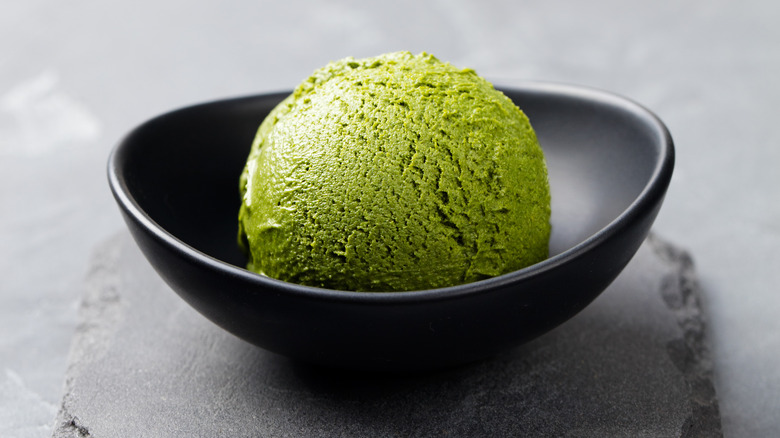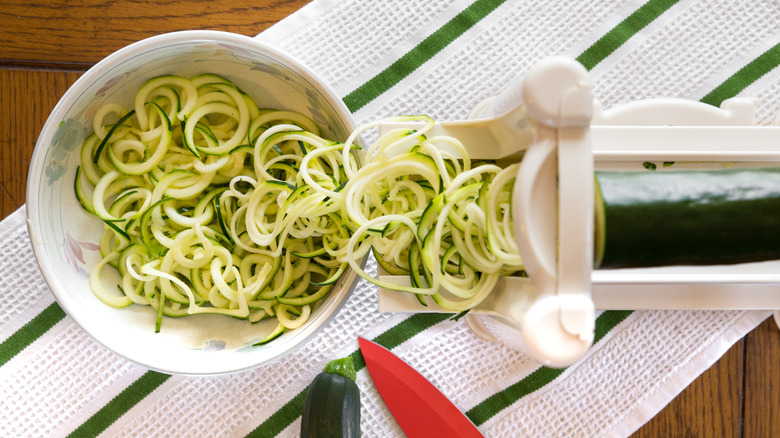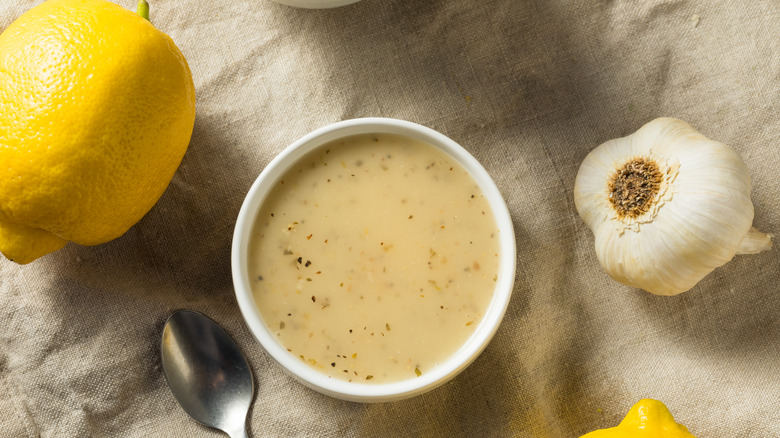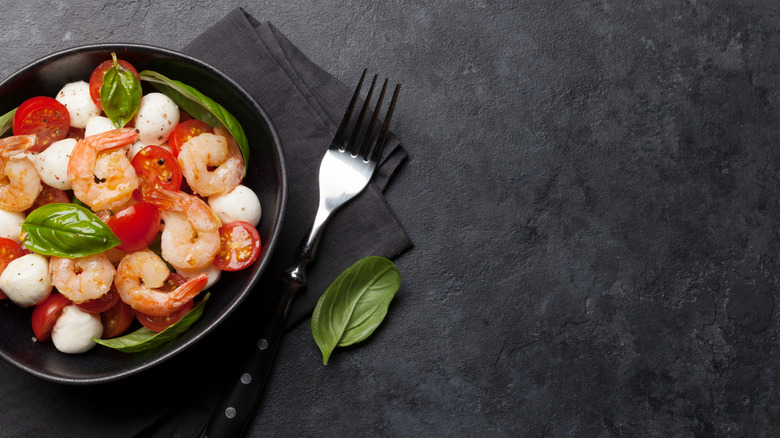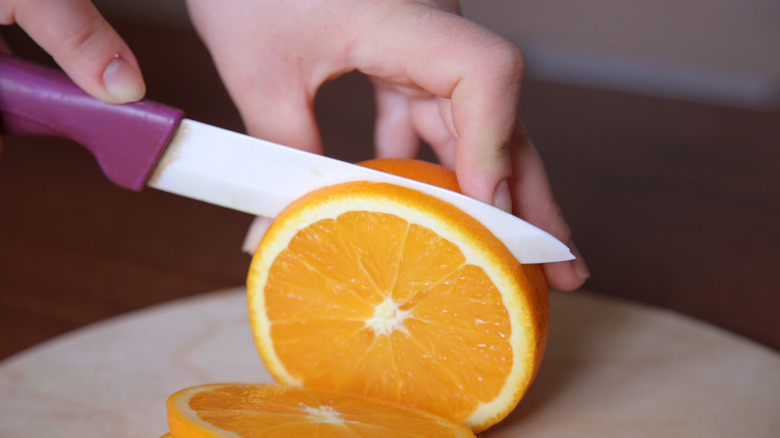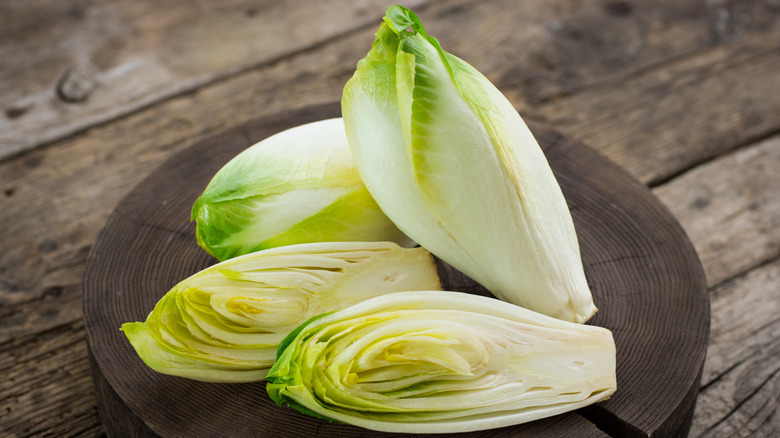12 Ways Celebrity Chefs Upgrade Their Caprese
One thing we can rely on celebrity chefs for is putting their own twist on simple, classic foods like macaroni and cheese or flavorful dips like guacamole. Naturally, Caprese isn't overlooked when culinary professionals look for ways to make foods bigger and better. There are plenty of ways to enhance it because the standard components in the salad include plump tomatoes, fresh mozzarella, and aromatic basil leaves. Then, folks usually top it off with a light touch of extra virgin olive oil.
These components combined create a light and dreamy salad with various textures. It's effortless to assemble and even easier to indulge in, so it's no wonder why the dish is so timeless. However, if you want to experiment with it, you can take inspiration from kitchen experts who know a thing or two about food pairings. From turning the dish into a protein-packed seafood salad to maintaining its refreshing essence with citrus, the methods of these experienced culinarians are beyond brilliant.
1. Include eggplant: Martha Stewart
Regarding Caprese, Martha Stewart ensures that her version of the dish contains layers of flavor depth. To be exact, Stewart makes grilled eggplant to serve as part of her dish, as she stated in an Instagram post. Caprese is commonly enjoyed on warmer days when it's the ideal time to heat the BBQ and cook outdoors, so it's a fantastic opportunity to use grilled ingredients. However, you can use this ingredient in your Caprese even if you don't own an outdoor appliance because an indoor grill creates a similar outcome. Stewart slices the eggplant thinly, much finer than her tomatoes, which makes the cooking time quick.
In addition, the grill brings sweet flavors to the eggplant, which gives the fruit a tender consistency that aligns with the soft cheese and tomatoes. Moreover, a smoky undertone presents itself when you grill food compared to if you just cook it on the stovetop, so when she took this route for her Caprese, it was undeniably a smart move. There are numerous types of eggplants, with the American eggplant (also known as Globe eggplant) likely the one you always see in the grocery store. However, other varieties work in Caprese, such as Chinese, Fairy Tale, and Japanese, so the choice is up to you.
2. Sprinkle brown sugar on the tomatoes: Alex Guarnaschelli
Alex Guarnaschelli shared an Instagram post where she showcased her vivid Caprese dish with large tomato slices, cheese, and fresh herbs. Most Caprese stops at those elements besides olive oil, but Guarnaschelli noted how she supplements the tomatoes with brown sugar. The molasses-filled sugar highlights the natural sugars in the tomatoes and cuts the acidity. So, Guarnaschelli's way of transforming her Caprese is similar to how some folks add brown sugar to their spaghetti sauce, except with this trick, the results are almost instantaneous, and you don't need to wait for anything to cook.
Since the tomatoes naturally have water, the sugar absorbs rather easily, so it isn't as if it gives the salad a grainy texture. Instead, it creates a paste-like mixture, depending on how much you add. She also noted on the social media post how she includes pesto in the Caprese, but the brown sugar doesn't need the pesto to do its job. Both light and dark brown sugar work, so you can grab whichever you have in your pantry next time you assemble Caprese.
3. Grill the tomatoes: Giada De Laurentiis
Similar to how Martha Stewart grills eggplant, Giada De Laurentiis told Food & Wine that she grills her tomatoes for her Caprese salad. You might wonder what grilling does for the already soft fruit, and the answer is that it magnifies the sugary undertone, and for tomatoes that aren't quite as ripe as they should be, it aids in the ripening process. Before De Laurentiis tosses the tomatoes onto the BBQ, she slices them, lightly oils them, and sprinkles on various herbs and seasonings. Since tomatoes are rather delicate under high heat, it doesn't take long at all for them to become charred or, at the very least, obtain some gorgeous grill marks.
So, if you try this out yourself, watch the fruit as it grills so that you don't overcook it. As for plating, De Laurentiis assembles the salad while the tomatoes are still warm from the BBQ; this slightly heats the mozzarella, which presents a melt-in-your-mouth consistency. In addition, it makes for a unique Caprese since people traditionally serve it with all the ingredients chilled. De Laurentiis sometimes roasts the tomatoes in the oven instead, which takes much longer, but the outcome is comparable, so you can try that if it is not an option for you to grill.
4. Drizzle on balsamic reduction: Ree Drummond
Many folks drizzle plain balsamic vinegar (or balsamic salad dressing) onto the Caprese, but Ree Drummond enhances the vinegar's texture and intensity, which is why her technique is noteworthy. Drummond mentioned on the Food Network's Facebook account that she creates a homemade glaze made with pure balsamic vinegar; no other ingredients are required. She allows the vinegar to simmer on the stovetop until it reduces and becomes much thicker in consistency. In turn, the flavor is exceptionally robust because it becomes concentrated. The dark, syrupy mixture also boosts the salad's presentation because of the dramatic color contrast against the other elements.
"The Pioneer Woman" pours the glaze lines onto sliced tomatoes, cheese, and large basil leaves; she pairs it with an olive oil drizzle and the timeless combination of salt and pepper. Although it takes time to make the glaze and allow it to cool before use, the extra effort is noticeable when you dig into the dish. If you plan to try Drummond's idea, buy the finest quality vinegar that you can get your hands on so that the flavor turns out as pleasing as possible.
5. Garnish it with dried oregano: Gennaro Contaldo
Rather than exclusively sprinkling salt and pepper onto the Caprese salad, Gennaro Contaldo uses dried oregano to amp up the dish, too (via YouTube). He doesn't use just any dried oregano, though, because he doesn't use a shaker that you purchase from the store. Instead, he uses a whole dried flower bunch and holds it over his assembled Caprese. Contaldo gently squeezes the dried plant, which loosens the oregano, making its pieces gracefully fall onto the salad. The reason why it's best to use dried oregano instead of fresh is that it's much more forceful. When the plant dehydrates, all of its earthy and peppery qualities heighten.
Not everyone has access to bouquets of oregano, so the product that comes in a container or jar is still feasible; it just isn't as fragrant. Either way, it's a step up from the fresh leaves, which are more mild tasting in nature. After all, Caprese already includes basil, so the dish doesn't lack fresh greens. Moreover, oregano pairs with tomatoes and mozzarella; when you add it to Caprese, it works as an excellent garnish because it adds flavor without making the famous salad unrecognizable. Instead, it works with the components to make the standard recipe more striking.
6. Top it with caramelized onions: Jean-Pierre Brehier
One way to make your Caprese have incredible umami notes is to include caramelized onions, which is exactly what Jean-Pierre Brehier does on his YouTube channel. When the famous chef plates his Caprese, he first places thick tomato slices onto the plate, followed by rounds of mozzarella cheese. Next, he carefully takes a spoonful of the dark, sweet, yet savory onions and creates a small heap on the salad; this gives the dish height, a technique that many culinary experts swear by because it is appealing to the eyes. Lastly, he places thin basil shreds on top of the onions. So, when you eat the Caprese, you're first met with the smooth basil and jam-like onions before you taste the other elements.
These types of onions work with all sorts of meals; it's not uncommon for people to couple them with tomatoes on sandwiches and burgers, which is why it's so fitting in Caprese. This approach does take time, though. It can take up to an hour to perfectly caramelize the veggies, so it's a critical mistake if you rush the process because it prevents the full effect from occurring. In other words, the longer the onions have time to cook, the deeper the flavor (and color) they have. When you use this method, you have to wait for the ingredient to cool, too, so it is best to make this component in advance.
7. Include basil sorbet: Justin Warner
One thing is for sure: It's not every day that you serve sorbet as a component in Caprese salad. But when you look at the properties of Justin Warner's frozen inclusion (as seen on "Foodie Call with Justin Warner"), it makes perfect sense because he makes the sorbet from fresh basil. Also, it isn't so sweet that it tastes like a dessert or clashes with the other elements. Instead, the sorbet refreshes the palate and makes the dish more sophisticated. That's not to mention, the addition of sorbet maintains the salad's light nature. Warner adds lemon juice to the homemade component because it accentuates the fresh herb's taste; he also uses a dash of alcohol because it makes the sorbet's consistency less icy.
Furthermore, the sorbet's charming green color upgrades the salad's presentation. When he serves it, Warner only adds a small scoop to the plate and forms it into an egg-like shape known as a quenelle. Basil isn't the most common flavor for store-bought sorbet products, so if you want to try Warner's Caprese rendition, you likely need to make the sorbet from scratch as he does. Of course, you need equipment to make sorbet at home, specifically a blender (or food processor) and ice cream maker, so if you are lucky enough to have those, you should definitely take advantage.
8. Add zucchini noodles: Bryan Woolley
Bryan Woolley includes zoodles in his salad, which gives the dish more substance and provides an earthy, yet sweet taste. For folks who typically don't find Caprese to satisfy their hunger fully, the zucchini noodles take it from side salad level to entrée level in a matter of moments. The reason why this addition is complementary to the other ingredients is that he uses raw zucchini. Many folks create zucchini noodles and cook them; however, when you do so, they can easily become a watery mess if you're not cautious.
Specifically, Woolley allows the zucchini pieces to soak with extra virgin olive oil and balsamic vinegar for just under 20 minutes to infuse them with flavor. So, if he were to cook and soak them, they would be highly soggy. On the other hand, Caprese is known to have fresh herbs, cheese, and fruit, so it's delicious to serve the zoodles cold and directly after you marinate them. Ultimately, it isn't the noodle-making process that takes time, but marinating the zoodles that does. If you include this ingredient in your next Caprese, a spiral slicer is handy. And for people who don't own the fancy gadget, sometimes the grocery store sells already-sliced zoodles that you can buy.
9. Make garlic lemon dressing: Rachael Ray
Since the components in Caprese aren't dry or hard to chew, the dish doesn't need a dressing to shine, unlike some other salads that rely on a sauce to feel complete. While some folks use a small amount of plain olive oil or balsamic vinegar on their Caprese, it is often a finishing touch that enhances the presentation and provides a hint of extra flavor. However, Rachael Ray takes the extra step to create a homemade dressing for her variation of the famous salad. The unconventional technique of how she serves the dish imparts it with savoriness because she uses grated garlic and fresh lemon juice.
Tomatoes and garlic are a harmonious pair; the garlic has a way of making the entire meal incredibly rich. Meanwhile, the fresh citrus adds a tanginess that complements the grassy undertones of the mozzarella. The dressing upgrades the Caprese, whether you take the more traditional route and drizzle it as a garnish or toss the entire salad to coat it. However, since tomatoes (that hold water) and dressing are involved, the basil wilts much quicker than if you don't have a sauce, so you should enjoy it immediately after you assemble it.
10. Use basil shrimp as a component: Ayesha Curry
On her YouTube channel, Ayesha Curry makes her Caprese stand out by including seafood, specifically pan-seared basil-coated shrimp. The buttery yet salty flavor of the shrimp works well with the simple yet classic components in Caprese salad. Curry first tosses the shrimp in store-bought basil paste, which has an intense flavor and perfectly pairs with the fresh basil in the salad. Her idea is fantastic because shrimp cook rather quickly; it doesn't take hours of planning to season and include it. The only thing you need to do in advance is peel and devein the shrimp (after you wash it).
The hearty component becomes browned when you sear it, so its presentation improves the Caprese. Curry doesn't layer the shrimp between pieces of tomatoes and cheese, though; she creates a line of them alongside the chilled components. This is clever because the shrimp are pretty hot when they come directly from the stovetop. Like Ree Drummond, she also uses a balsamic reduction, which she pours over both the cold and hot ingredients. Ultimately, this method is ideal for seafood lovers, as the shrimp harmonizes with the other elements in the dish and provides a generous amount of protein in the process.
11. Include orange slices: Donatella Arpaia
Donatella Arpaia puts a creative twist on Caprese when she incorporates orange slices into the dish. You might wonder why this ingredient works so well; after all, the tomato in Caprese is already acidic, so why add another acidic component? Well, Arpaia omits the tomatoes altogether. However, that's not mandatory; you can surely include them if you try her technique. Arpaia's Caprese also has cinnamon sugar almonds, so the sugar and spices create balance in the meal. She also makes dressing with white balsamic vinegar, orange juice, and honey.
Then, of course, the mozzarella is milky, and the basil is sweet, so it's a pleasant combination. There are many ways to tweak Arpaia's method; folks can use mandarin oranges instead of large orange segments or slices. Furthermore, you can use only one variety of orange or use many types, which is what the famous chef does. Either way, citrus is a bright and lively addition for Caprese, especially when you enjoy it on warmer days.
12. Serve it with endive: Sandra Lee
Sandra Lee assembles her Caprese on pieces of endive (via YouTube); this provides a pleasantly crunchy texture that the salad often lacks because the basil leaves are more delicate, and the tomatoes and cheese are relatively soft. Endive belongs to the chicory plant species, and its leaves are the perfect size to make appetizers with, as it can essentially double as a chip that you top with ingredients. So, when Lee builds her Caprese salad, she piles mozzarella cheese, basil, and chopped tomatoes atop the endive boats.
Essentially, the bite-sized portions are advantageous for when you host a party because the Caprese transforms into finger food. To try this out yourself, you can cut cherry tomatoes into quarters or dice whole tomatoes into tiny pieces. As for the cheese, Lee uses shredded cheese, but you don't have to (although it is more effortless, which is what her show "Semi-Homemade Cooking" was all about). Nevertheless, mozzarella pearls are more elegant if that's what you are looking for. Plus, they have a fresher taste; chop them in half if they are too large to place on the endive leaves.
